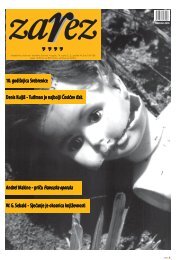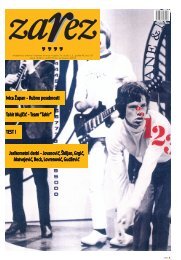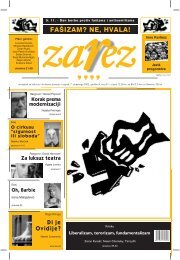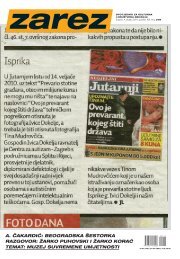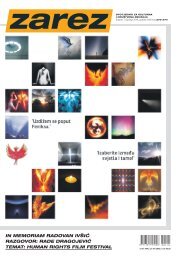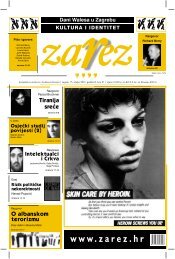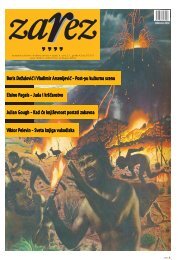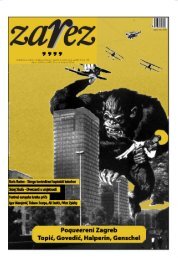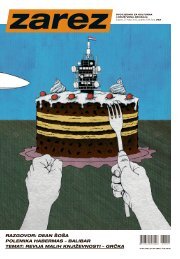28 II/40, 12. listopada 2,,,.Marinko ÈuliæTuðman –Anatomy ofUnenlightenedAbsolutismpublished by Feral Tribune, Split, 1999riting Franjo Tuðman’s politicalbiography (of sorts) while he isstill alive is like trying to fishwhile the river is up.”, warns MarinkoÈuliæ at the beginning of his book.This task was made even harder by thefact that at the time of writing, Èuliæ,a long-time journalist and editor at FeralTribune – literally the only <strong>Croatian</strong>paper with respectable circulationwho from its first issue onwards neversto<strong>pp</strong>ed o<strong>pp</strong>osing Tuðman and his regime– had to stand trial for the chargesbrought against him and Feral’seditor-in-chief, Viktor Ivanèiæ, by noneother than the offended Presidenthimself.Despite this delicate situation,Èuliæ rose to the challenge, a<strong>pp</strong>roachinghis “hero” less in a form of biographythan something closer to psychologicalportrayal. Consciously or not,the term “anatomy” in the title had alreadyset the medical tone of the proceedings.Whatever the case, the toneis justified, because what follows laterevokes the way in which the psychiatristdiagnoses the patient (implicitly,of course) by analyzing his actions andbehavior.Èuliæ is coolly objective, and precisein his argumentation, but there is ahint of subtle compassion for the “case”he is treating. He analyzes Tuðmanprimarily through his relationship withseveral figures from recent pastwho, each in his own way, fascinatedand inspired him: Tito, Paveliæ andFranco (“Fascism and antifascism aretwo planks that help him walk on water”),and through his relationship withhis only living “idol”, and the onlyreason that he managed to hold on topower for the entire decade – SlobodanMiloševiæ (“What we have here isthe symbiosis between a man(Miloševiæ) who had a Berlin Wall collapsein front of him, preventing himfrom going further, and a man (Tuðman)who was fortunate enough to havethe Wall collapse behind him.”).Three concrete political exampleson which Èuliæ builds his case are alsothree main Tuðman’s obsessions, onwhich he built his “unenlightened absolutism”– division of Bosnia andHerzegovina, the Serbian question inCroatia and abolishment of distinctionsbetween victims of fascism andcommunism (what Feral Tribune called“bones in the blender”).How will the people see Tuðmanoff – as a Liberator and a Nation-builder,or as an Autocrat and Dictator?Èuliæ’s “biography” is his attempt toat least glean the answer to that question.In the interview he gave to <strong>Zarez</strong>before his book was about to be published,he was explicit: “I think thatthose with guilty conscience will startdiscrediting him as soon as he dies,and I have to admit that I find it a littleunfair, considering that they were theones who kept giving him their wholeheartedsu<strong>pp</strong>ort for a very long time.You know what ha<strong>pp</strong>ened with Tito:first we had this big, charismatic death,than he was discredited, and now he’sback in favor. Tuðman won’t be so lucky.He made so many mistakes andstupid moves in the past ten years thatit won’t be long before everyone renounceshim. The man will probablysink lower than Franco.”Now that the citizens of Croatia,whatever their political bent, regardFranjo Tuðman primarily as a baddream they had a long time ago, thisprediction sounds as if Èuliæ was reinventingthe wheel. However, you onlyhave to look at the sullen eyes and thetightly pressed lips on the book coverto remember, and admit, how daringand optimistic, even unbelievable, thisstatement sounded in the summer of1999.Marinko Èuliæ probably still has hisnotes for the biography of SlobodanMiloševiæ, a project that never got offthe ground thanks to some publishingand distribution problems. That’s a pity.A lot of things may have been clearertoday if it had.Agata JunikuPetar LukoviæTheBreakdown YearsA Chronicle of SerbianDownfallpublished b: Feral Tribune, Split, 2000etar Lukoviæ’s The Breakdown Yearsis an exceptional, excellently written,deliriously poignant and deliriouslywitty book. We are talking about a totalbook or a sum total of Serbian downfall thatwas ten years in the making. It expressespossibly the strongest o<strong>pp</strong>osition yet toMiloševiæ’s imperialist politics and the generalnationalist/ideological/mythologicalmatrix which the Serbian regime has beenusing for the past ten years to create theicon of the imperiled and righteous heavenlynation. Moreover, everything that is distinctivein Lukoviæ’s writing, from histhoughts and the topics he discusses to hisstyle and language, is diametrically o<strong>pp</strong>osedto everything that the Serbian governingbody had to offer during those years. ThusLukoviæ responds to mass hysteria of patriotismwith indifference/rage/laughter regardinghis duties towards the fatherland.He puts his urban identity, public spirit andindividualism before provincial, tub-thumpingmentality, and his love of rock music,universal parody and literary fiction beforethe revival of orthodox faith, historicalmyths and tribal/patriarchal spirit that dominatesSerbia. In short, Lukoviæ fights theten years of Miloševiæ’s tyranny and nationalisteuphoria, both Serbian and <strong>Croatian</strong>,with a healthy common sense and a healthyhumor.The Breakdown Years, subtitled A Chronicleof Serbian Downfall, contains articlesthat this music critic and journalist publishedin the period from 1993 to 1999 in variousmagazines, from Belgrade independentweeklies Vreme and Nedjeljna Naša Borba,Slovenian Mladina, Sarajevo’s Dani andSplit’s Feral Tribune to Internet. He also puttogether a special Informative Guide (or,The Hall of Fame), which lists the main “heroes”of The Breakdown Years, from folkstars, women mystics, heavenly warriors,would-be journalists, writers and spiritualrestorers of Serbianhood to various ministersand politicians - both the ones belongingto the regime and those who belong toquasi-o<strong>pp</strong>osition - as well as their wives, andgenerally speaking, a whole battalion ofprofessional Serbs. Articles are prefaced withsome of the most famous, most terrifyingand most insane quotes of the period, sothat every text in the book boasts its ownanti/motto. One of the most famous is certainlyMiloševiæ’s “If we have to fight, byGod, we will fight!” This nursery of stupidityserves almost as a sequel to The Anthologyof <strong>Contemporary</strong> <strong>Croatian</strong> Stupidity,compiled by writers from Feral Tribune, andat the same time represents a perfectly reliable,documentary material for better understandingof the history/reality of Serbiandownfall. The other su<strong>pp</strong>lement to thebook is a collection of e-mail messages thatLukoviæ received from friends and strangersduring the NATO bombing of Serbia(after he made his e-mail address public inFeral Tribune), and which have been chronologicallyarranged and entered in his electronicjournal…Lukoviæ uses different journalistic and literarygenres to record the decaying Serbianhistory and its decaying reality: fromnewspaper columns and reportage, his andother people’s diary entries to the fantastical-documentaristnovel named Psycho anddramatic fragments, or rather, palimpsestsof famous literary works, here entitled PulpFiction. One unique genre he introducesconsists of the stolen letters of MirjanaMarkoviæ (Miloševiæ’s wife), Borislav Joviæor Radoje Kontiæ, and confidential transcriptsfrom the sessions of the SupremeDefense Council. In addition to this varietyof genres and authorial mimicry, Lukoviæ alsoemploys numerous literary techniquesand linguistic/stylistic acrobatics, such asdifferent types of parody, compilation andparaphrase of other people’s speech; grotesque,satire and irony; hyperbole, Rabelaisianstylistic reversals, self-irony and many,many more.Nevertheless, a laughter of Pero from theOther Side is the laughter that liberates; itrepresents a heretical, rebellious and at thesame timeprofoundlyethical andhumane testimonyagainstthe realitythat surroundshim… Inwritingthechronicle ofone nation’sdownfall andidentifyingthe boundariesof madnessin regionsof former Yugoslavia, Lukoviæ is not interestedin serious political analysis, logicaldissection of the situation or predictionsfor the outcome. Most of his texts deal withthe daily life, a bizarre and schizophrenicdaily life filled with watching the news onSerbian state-owned television, reading Politika,waiting for water, gasoline, electricity…or, in more general terms, they recordthe insanity in which Lukoviæ lives...The Breakdown Years is the funniest,most comprehensive and most movingchronicle of the madness of Serbian regime,but also a general history of stupidity thatwas being produced in the region for the lastten years. It is a cutting condemnation, afirst-rate satire superior to almost anythingelse by contemporary authors, especiallywhen we take into account, and this is important,that to write like this in a place likeSerbia implies considerable courage andpersonal dedication… Laughter and writingmay be the last resorts of reason - but whatendless possibilities they have.Katarina LuketiæStanko LasiæAutobiographicalNotespublished by Nakladni zavod Globus,Zagreb, 2000lthough the publishing of autobiographicalwritings by the respected literarytheorist and historian StankoLasiæ (b. 1927) probably caught most of the<strong>Croatian</strong> reading public by surprise, audienceinitiated into his literary and scholarlyoeuvre could have predicted such a text fromthe discourse that emerges from the previoussix books of Lasiæ's Krleology (1989, 1993).Lasiæ's analytical and scholarly subject presentshis own life as a place of experience,temptations, restlessness and dialogue, i.e. asmaterial for transforming the personal experienceinto the narrative act, which meansthat with Lasiæ, some sort of Bildungsromanwas waiting for its chance for quite some time.Based in part on his conversations withBranko Matan, Lasiæ's Autobiographical Notesfulfill indications already present in Krleology.Whenever the autobiographical discoursein employed, the most frequently askedquestions are, on one hand, how to establishcharacteristics of the subject that narrates itsown life, and, on the other, how to define"real" subject's relationship with the narrativesubject; with the "character" of life historythat is produced only by enunciation. Who is"Lasiæ" made by Lasiæ's authorial discourse?Does Lasiæ produce his "wishful" self or is hereally openingup to thepotential reader,with allhis weak spots,delusionsand contradictionslaidbare? The answercould befound in centralformativetouchstonesof Lasiæ's(hi)story; theones that permeatethreecentral relations between the world and thetext. Firstly, Lasiæ's treatment of historicalexperiences (Second World War, Ustashas"Independent State of Croatia", his involvementin antifascist movement, acceptance ofthe totalitarian Communist matrix, its subsequentrejection, participation in the "<strong>Croatian</strong>spring" in 1971, emigration). Secondly,Lasiæ's relationship to himself (intellectualcoming of age, reading lists, learning, disciplineand scholarly “fit-ness”). And finally hisrelationship with Others (o<strong>pp</strong>onents, colleagues,friends, family, Europe). Lasiæ the storytellerskillfully pieces all of these elementstogether and the (hi)story produced becomesflavored with self-reflection that turnshis autobiographical pages into one of themost impressive intellectual testimonies ofthe recent <strong>Croatian</strong> history.Although he performs the role of the storytellerwell, Lasiæ has difficulties with avoidinghis other favorite roles, for instance theone of the literary scholar, classificator orsystematic analyst. The text reveals manytraces of author's profession, which makesthe decision on whether one should understandAutobiographical Notes as a story aboutthe personal life or the story about socialsystem difficult to make; is it a discourse thatshapes life and then transfers is back to beinga "system" (through the process of author'sreflection) or is it the other way round:system is a<strong>pp</strong>lied to personal life and thereforemade more "personal". In any case, weare presented with an impressive book. I amsure some people will find it terrifying (itdoes, after all, discuss bloody history, totalitarianregimes, hard, self-imposed scientificdiscipline and deep self-analysis), but to manyothers it will bring the pleasures of reading,gaining insight, dialogue and encounteringthe discoursive Other.Dean Duda
II/40, 12. listopada,,,. 29Krešimir BagiæArt of DissentPolemic Styles of, A.G. Matošand M. Krleapublished by Naklada MD, Zagreb, 1999roatian literature contains a ratherlarge corpus of polemical texts, which,until now, lacked systematic historicalanalysis and presentation. After openinghis book on polemical writings withthis statement, Krešimir Bagiæ goes on toemphasize the necessity of thorough research,in light of the fact that insight into polemicalpraxis of <strong>Croatian</strong> literature is mandatoryfor any understanding of <strong>Croatian</strong> literaryperiods. Bagiæ suggests the polemicaltexts of Matoš and Krlea as the best possibleexamples of the polemical genre duringthe period when these authors wrotetheir works.In order to be fair, in his introductorynote Bagiæ tries to prove the possibility ofconceptualizing literary polemic as a recognizablegenre, at the same time disputingthe genre history, different textual forms inwhich the polemical content a<strong>pp</strong>eared andthe "polemical style" as trans-genre andtransdisciplinary phenomenon.(...) Art of Dissent describes basic featuresof a literary polemic, its character, practice,styles and goals of its participants, aswell as its social function within the particularliterary community. Bagiæ also offersuseful advice on how to conduct a polemicwith the examples from both the older andmore recent polemical debates, where, if weare to believe the author, knocking out youro<strong>pp</strong>onent after the round has been completed(à la Mike Tyson) is perfectly acceptable,and if that fails, the <strong>Croatian</strong> polemicalpractice has already demonstrated the advantagesof simply attacking your rival inthe middle of the street.Igor ŠtiksStanko AndriæMiraclesof JohannesCapistranusPublished by Hrvatski institut zapovijest - podrunica za povijestSrijema i Baranje and Matica hrvatskaOsijek, Slavnoski Brod-Osijek, 1999roatian reading audience knowsStanko Andriæ (b. 1967) primarilyfor his previous two books: Historyof Slavonia in Seven Conflagrationsand Encyclopedia of Nothingness. Duringthe <strong>Croatian</strong> '90s, both books establishedStanko Andriæ as a genuinely originalauthor whose texts defy sharp boundariesof literary classification within anygiven genre. It remains uncertain whetherHistory of Slavonia in Seven Conflagrationsshould be understood as a fictionalwork with historiographical background,or a metafiction, or else as apostmodern historiography. But thesequestions started to disentangle after thearrival of Andriæ's second book, Encyclopediaof Nothingness, which pointed ustoward the interpretation of StankoAndriæ as a fictional writer; certainly thewriter who insists on "fantastical su<strong>pp</strong>lements"to reality. Being a competent narrator,Andriæ nevertheless fascinates hisreaders with the scope of his historiographicalknowledge, thereby casting hisextraordinary fictional net while using thefactual data. (...)As a whole, monograph Miracles of JohannesCapistranus follows the chronologicalthread of Capistranus’ life, endingonly after the saint's death and interpretingmiracles performed during the "real" timeof Capistranus’ sainthood, after his actualdeath. This performance of sainthoodis essential for the understanding of hagiographicdiscourse and its functions, especiallyif we keep in mind that these functionsremained unchanged during manycenturies after the physical death of particularsaints. (...)While in his other fictional works Andriæplayed with the relationship between fictionand reality, in the work about saintlyacts of Johannes Capistranus the authordecided to make the ontological differencebetween fiction and reality the mainsubject of his analysis. Hence the monographstarts with a detailed, step-by-ste<strong>pp</strong>ortrayal of Capistranus’ historical journey(locating his stations, his encountersand real references in Slavonian history),and it ends with the discovery of the mechanismsof miraculous reality "estrangement".Andriæ groups Capistranus’ miraclesaccording to the manner of their productionand/or to the fictional status ofthe event. The classification of miracles finallybuilds into a seven-step scale whichdepicts rather contradictory miracles –from the entirely fictional ones and thosethat are pure deception, also includingcoincidences and self-suggestions, to thecases where the measure of miraculous isobviously a product of "stylization" orquoting from the unreliable story-transfer.Andriæ refuses the possibility to translatethe difference "fiction/reality" in theworld of miraculous with a statement that"the miracles were simply illusionary". Onthe contrary, Andriæ considers the phenomenonof miraculous performance a permanentand active element of the wholemedieval reality. Disciplines like religion,experiences with magic, psychologicalschools of thought certainly helped himin this interpretation of reality... – variouselements of medieval reality that contributedto the forceful process of spiritualizationduring the Middle Ages.With his conclusive remarks, Andriæ deliversa persuasively well-rounded monographdedicated to Johannes Capistranusand Slavonia, the homeland of both Capistranus’saintly deeds and Andriæ'sscholarly research. The book Miracles ofJohannes Capistranus should earn itselfthe highest place within Andriæ's oeuvre,and the status equal in scope and qualityto any contemporary European studyabout medieval hagiography.Andrea ZlatarSlobodan Prosperov NovakA Historyof <strong>Croatian</strong><strong>Literature</strong> IIIpublished by Naklada anti-BARBARUS,Zagreb, 1999he third volume of A History of<strong>Croatian</strong> <strong>Literature</strong> by SlobodanP. Novak boasts a chronometricaland periphrastic subtitle: "From Gunduliæ'sThe Spawn of Darkness to PleasantConversation of Slavic People (1756)",and thanks to its simple and relaxedcomposition, it is as difficult to review asit was easy to read. Much like the firsttwo volumes in the edition, the third volumeconsists of short and independentlytitled chapters, mostly dealing withparticular literary works and arrangedaccording to their completion or releasedate. Since chapters are not arranged hierarchically,even the texts that have somethingin common are never groupedunder any single heading or title. (...)After decades of employing the sameclassification, A History of <strong>Croatian</strong> <strong>Literature</strong>,VOL. III, breaks the traditionby refraining from the use of the word"baroque" in discussions of seventeenthcentury <strong>Croatian</strong> literature. (...)But Novak's disregard for the baroque asa period designation is only a symptomof his disregard for the periodisation ingeneral. He is equally dismissive of theterm Enlightenment, although he doesuse it in one of the book subtitles, i.e. asthe title of an individual chapter ("TheFirst Enlightenment"). However, whendiscussing the individual writers of theperiod in the same chapter, he never usesthe term, neither as programmatic ideanor as heuristic hypothesis. (...)A second major criterion that Novaksystematically avoids when dealing withchronological orientation and division isthe concept of literariness, despite thefact that this very concept has beenkeenly discussed and carefully a<strong>pp</strong>lied in<strong>Croatian</strong> literary studies, regardless ofwhether they employ a philological, historicalor theoretical a<strong>pp</strong>roach. (...)Novak does not distinguish betweena review of lyrical poetry and a review of"Illiric" dictionary, or between an essayon baroque epic poem and the one onanatomy atlases: they mesh quite effortlesslyunder his treatment. The proximityof such disparate literary items rendersthe book confusingly "light", but italso reflects the author's effort to distancehimself from historical and scholarlyholism. This could be interpreted as Novak'sreadiness to (mis)use metahistoricalperspective and stretch the argumenttowards the attitude that all early modernliteracy could be treated as literature.To be fair, we should keep in mindthat Novak's disobedience to the canonof literary science theoretical vocabularydoes not serve only as a distinguishingfeature of his book; it can also be understoodas a mark of its modernity. A His-tory of <strong>Croatian</strong> <strong>Literature</strong> III shows obviouspreference for anti-holistic thinkingtypical of the recent fin de siecle atmosphere,so much so that it refuses tooperate under the notion of "historicalobjectivism" (which is a legitimate contemporarya<strong>pp</strong>roach) or to abandon theconcept of "little history".All in all, by departing from the usualperiodisation and classification standards,the third volume of Novak's Historyof <strong>Croatian</strong> <strong>Literature</strong> (much like the firsttwo volumes) has succeeded in posinga formidable challenge to <strong>Croatian</strong> scholarsof literature and history). The truevalue of this book lies not in the author'snonchalant attitude towards universaliaof literary history, but rather in the sensibleusage of the advantages that comewith that nonchalance. When we disregardthe general terms, we also make roomfor the rehabilitation of particularities.In Novak's book, the particular winshands-down. Chapters on individual literaryworks and writers' oeuvre, understoodas unique historical events, arewritten imaginatively and without a traceof predictability, and the a<strong>pp</strong>roach to individualworks remains well-roundedand free from theoretical abstractions,heuristic hypotheses or a predeterminedanalytical program. This newly won freedomdoes not equate emptiness, and forthat let us be thankful to Novak's alreadyestablished large experience with literarytexts, to his knowledge (acquired throughscrupulous and passionate reading ofscholarly literature), to his famous arsbene dicendi (as witnessed in Novak'searlier works), and, finally, to his engaging,and frequently illuminating metaphors.Zoran KravarThe MiroslavKrleaEncyclopedia I/IIandBibliography of MiroslavKrleaby Davor Kapetaniæpublished by "Leksikografski zavodMiroslava Krlee", Zagreb 1993/99he making of The Miroslav Krle-a Encyclopedia took fifteenyears, and the whole researchwas conducted under the guidance ofVelimir Viskoviæ. In the summer of1993, the first volume (letters A-LJ)was published, and this autumn bringsus the final volume (letters M-) withBibliography of Miroslav Krlea by DavorKapetaniæ. In composing and editingof Krlea's literary and personalglossary, more than fifty relevant authorswere included: from literary historians,critics and theorists to philosophers,philologists, historians, andjournalists... Together they preparedalmost two thousand encyclopedic entries.The basic principles of encyclopedicalclassification were based onthe diversity of Krlea's activities onone hand, and on the desire to paint adetailed portrait of Krlea on the other.Separate encyclopedic articles arededicated to Krlea's texts, his publicactivities, esthetical attitudes and beliefs,his translators and propagandistsand finally, members of his family...Krešimir Bagiæ
- Page 2 and 3: 2 II/40, 12. listopada 2,,,.gdje je
- Page 4 and 5: 4 II/40, 12. listopada 2,,,.Davorka
- Page 6 and 7: 6 II/40, 12. listopada 2,,,.Nakladn
- Page 8 and 9: 8 II/40, 12. listopada 2,,,.Andrea
- Page 10 and 11: 10 II/40, 12. listopada 2,,,.Pjesni
- Page 12 and 13: 12 II/40, 12. listopada 2,,,.U uvod
- Page 14 and 15: 14 II/40, 12. listopada 2,,,.Irena
- Page 16 and 17: 16 II/40, 12. listopada 2,,,.o you
- Page 18 and 19: 18 II/40, 12. listopada 2,,,.n her
- Page 20 and 21: 20 II/40, 12. listopada 2,,,.In you
- Page 22 and 23: 22 II/40, 12. listopada 2,,,.Roman
- Page 24 and 25: 24 II/40, 12. listopada 2,,,.Miljen
- Page 26 and 27: 26 II/40, 12. listopada 2,,,.Sonja
- Page 30 and 31: 30 II/40, 12. listopada 2,,,.Igor M
- Page 32 and 33: 32 II/40, 12. listopada 2,,,.eljko
- Page 34 and 35: 34 II/40, 12. listopada 2,,,.FRAKCI
- Page 36 and 37: 36 II/40, 12. listopada 2,,,.Miljen
- Page 38 and 39: 38 II/40, 12. listopada 2,,,.Sonia
- Page 40 and 41: 40 II/40, 12. listopada 2,,,.Marink
- Page 42 and 43: 42 II/40, 12. listopada 2,,,.Igor M
- Page 44 and 45: 44 II/40, 12. listopada 2,,,.eljko
- Page 46 and 47: 46 II/40, 12. listopada 2,,,.Frakci
- Page 48: 48 II/40, 12. listopada 2,,,.Hrvoje




